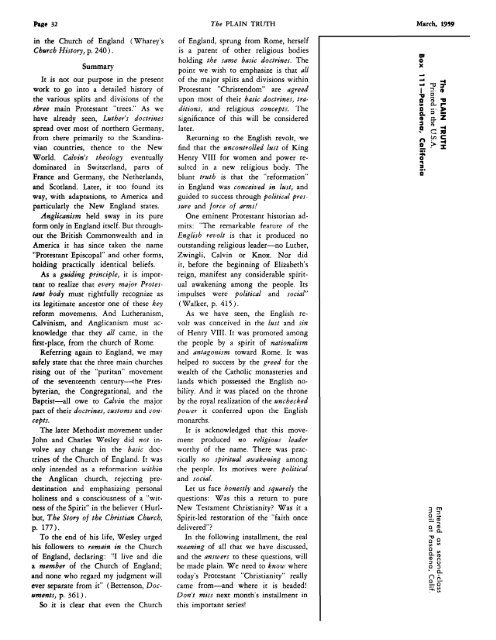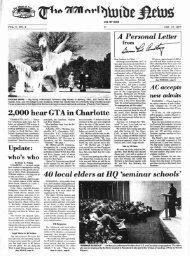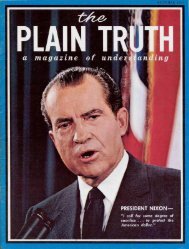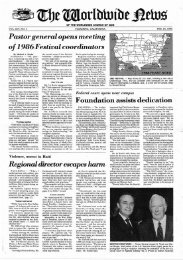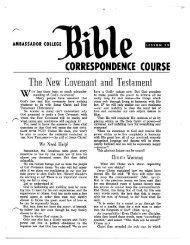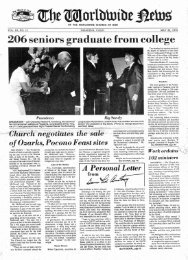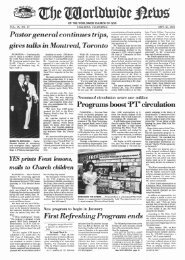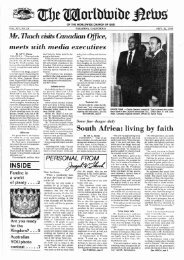Plain Truth 1959 (Vol XXIV No 03) Mar - Herbert W. Armstrong
Plain Truth 1959 (Vol XXIV No 03) Mar - Herbert W. Armstrong
Plain Truth 1959 (Vol XXIV No 03) Mar - Herbert W. Armstrong
Create successful ePaper yourself
Turn your PDF publications into a flip-book with our unique Google optimized e-Paper software.
Pqe 32<br />
in the Church of England<br />
Church History, p. 240).<br />
Summary<br />
(Wharey's<br />
It is not our purpose in the present<br />
work to go into a detailed history of<br />
the various splits and divisions of the<br />
three main Protestant "trees." As we<br />
have already seen, Luther's doctrines<br />
spread over most of northern Germany,<br />
from there primarily to the Scandinavian<br />
countries, thence to the New<br />
World. Calvin's theology eventually<br />
dominated in Switzerland, parts of<br />
France and Germany, the Netherlands,<br />
and Scotland. Later, it too found its<br />
way, with adaptations, to America and<br />
particularly the New England states.<br />
Anglicanism held sway in its pure<br />
form only in England itself. But throughout<br />
the British Commonwealth and in<br />
America it has since taken the name<br />
"Protestant Episcopal" and other forms,<br />
holding practically identical beliefs.<br />
As a guiding principle, it is important<br />
to realize that every major Protestant<br />
body must rightfully recognize as<br />
its legitimate ancestor one of these key<br />
reform movements. And Lutheranism,<br />
Calvinism, and Anglicanism must acknowledge<br />
that they all came, in the<br />
first.place, from the church of Rome.<br />
Referring again to England, we may<br />
safely state that the three main churches<br />
rising out of the "puritan" movement<br />
of the sevenreenrh cemury-the Presbyterian,<br />
the Congregational, and the<br />
Baptist-all owe to Calvin the major<br />
part of their doctrines, customs and concepts.<br />
The later Methodist movement under<br />
John and Charles Wesley did not involve<br />
any change in the basic doctrines<br />
of the Church of England. It was<br />
only intended as a reformation within<br />
the Anglican church, rejecting predestination<br />
and emphasizing personal<br />
holiness and a consciousness of a "witness<br />
of the Spirit" in the believer (Hurlbut,<br />
The Story of the Christian Church,<br />
p. 177).<br />
To the end of his life, Wesley urged<br />
his followers to remain in the Church<br />
of England, declaring: ':1 live and die<br />
a member of the Church of England;<br />
and none who regard my judgment will<br />
ever separate from it" (Berrenson, Documents,<br />
p. 361).<br />
So it is clear that even the Church<br />
The PLAIN TRUTH<br />
of England, sprung from Rome, herself<br />
is a parent of other religious bodies<br />
holding the same basic doctrines. The<br />
point we wish to emphasize is that all<br />
of the major splits and divisions within<br />
Protestant "Christendom" are agreed<br />
upon most of their basic doctrines, traditions,<br />
and religious concepts. The<br />
significance of this will be considered<br />
later.<br />
Returning to the English revolt, we<br />
find that the uncontrolled lust of King<br />
Henry VIII for women and power resulted<br />
in a new religious body. The<br />
blunt truth is that the "reformation"<br />
in England was conceived in lust, and<br />
guided to success through political pressure<br />
and force of arms!<br />
One eminent Protestant historian admits:<br />
"The remarkable feature of the<br />
English revolt is that it produced no<br />
outstanding religious leader-no Luther,<br />
Zwingli, Calvin or Knox. <strong>No</strong>r did<br />
it, before the beginning of Elizabeth's<br />
reign, manifest any considerable spiritual<br />
awakening among the people. Its<br />
impulses were political and social"<br />
(Walker, p. 415).<br />
As we have seen, the English revolt<br />
was conceived in the lust and sin<br />
of Henry VIII. It was promoted among<br />
the people by a spirit of nationalism<br />
and antagonism toward Rome. It was<br />
helped to success by the greed for the<br />
wealth of the Catholic monasteries and<br />
lands which possessed the English nobility.<br />
And it was placed on the throne<br />
by the royal realization of the unchecked<br />
power it conferred upon the English<br />
monarchs.<br />
It is acknowledged that this movement<br />
produced no religious leader<br />
worthy of the name. There was practically<br />
no spiritual awakening among<br />
the people. Its motives were political<br />
and social.<br />
Let us face honestly and squarely the<br />
questions: Was this a return to pure<br />
New Testament Christianity? Was it a<br />
Spirit-led restoration of the "faith once<br />
delivered"?<br />
In the following installment, the real<br />
meaning of all that we have discussed,<br />
and the answers to these questions, will<br />
be made plain. We need to know where<br />
roday's Protestant "Christianity" really<br />
came from-and where it is headed!<br />
Don't miss next month's installment in<br />
this important series!<br />
<strong>Mar</strong>ch, 1''9<br />
III<br />
0<br />
)(<br />
--"ti-t<br />
.., _. It :::r<br />
I<br />
'V ....<br />
0 D t'I> 'V<br />
I/O<br />
~); o _<br />
D<br />
D-<br />
It ;.Z<br />
::I t'I><br />
-t<br />
!' c::: lID<br />
n<br />
V>C . -t<br />
D<br />
... •.<br />
0<br />
:::I '"<br />
ii"<br />
t>:z:<br />
3 m<br />
o ::.<br />
~~<br />
o (1)<br />
-0.<br />
"'0<br />
~ CIl<br />
o CIl<br />
0.(1)<br />
(1) n<br />
::l 0<br />
o ::l<br />
- 0.<br />
n" o -<br />
-0<br />
_. CIl<br />
:-+'",


